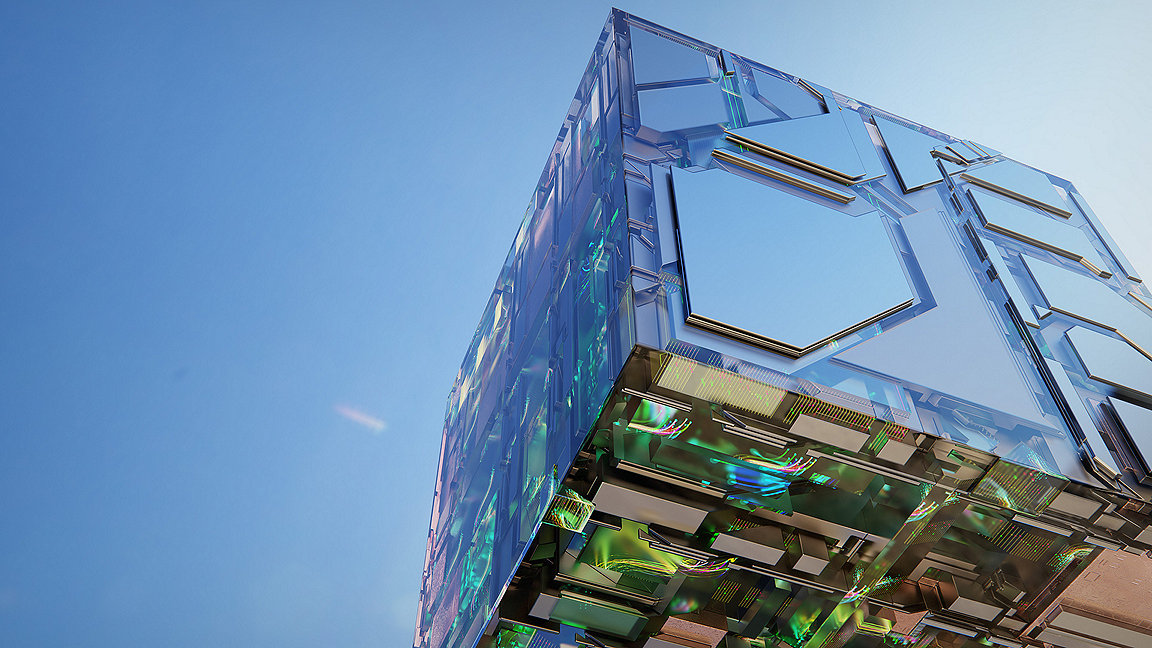
Images by Peter Crowther
Scientists at the UK’s Aston University have predicted that in the next three years the total amount of data in the world will increase by 300%.
All those WhatsApp messages, undeleted screenshots, thank you emails and more have to be stored somewhere. And that means a physical space must contain this increased capacity, whether co-location or hyperscale data centres. Raw materials involved range from copper, silicon and lithium for the racks of servers, to the aluminium, steel and concrete of the actual buildings.
Ian Blakeman MRICS, UK and Europe technical data centre lead at global construction consultants Rider Levett Bucknall (RLB) goes into more detail: “Silicon or similar metals are more prevalent in the cabinets for the hardware and software and IT systems that are installed. Cabling, busbars, switch gear, and so on, all use enormous amounts of copper. And UPS (Uninterrupted Power System) machines have traditionally had valve regulated lead acid batteries backing them up.
“Nowadays, there's a big movement towards lithium-ion batteries. So, there's probably an increasing amount of lithium being used in data centres.”
Blakeman’s US-based colleague Paraic Morrissey MRICS adds: “We’ve been seeing the push towards using renewable energy, in terms of solar power and wind turbines. Using, for example, hydroelectricity is a move away from the materials that have a large carbon footprint – big batteries, diesel generators and fossil fuels – looking instead at more environmentally friendly options.”
The duo from RLB also highlight the pressure on the supply chain, which is backed up by figures from Turner and Townsend’s Data Centre Cost Index 2022. This states: “Data centre owners and operators are delivering against higher project costs than ever before, with escalating prices for energy and key materials squeezing historically healthy margins.” Specifically, the report points to price hikes for commodities like metals and energy resulting in increased costs for construction materials and components. Nearly three-quarters of those surveyed pointed to an increase in tender or bid prices of more than 15%. Nonetheless, the data centre sector remains extremely buoyant.
Kyle Goehring, Turner & Townsend’s head of sustainability, explains how tackling climate change and cost efficiency can work in tandem. “We're working a lot in the US, across North America and seeing great growth and opportunity with data centres in the telecom markets in Latin America. We’re seeing improvements in energy infrastructure and mining operations; more manufacturing of solar and wind systems. Data centres want to be as economical as possible. And if they can get clean green energy that aligns with some of their net zero goals, that makes sense.”

New materials and technologies
Design firm HDR is making inroads in several ways in terms of materials. “We’ve seen successive generations of data centres increase in density, which has reduced the quantity and cost of raw materials used in their structure and building enclosure,” says Kevin Henry, the company’s building engineering services manager. “Cooling infrastructure that can pivot between energy consumption and water consumption means that data centre design now strives to balance water and electrical usage. Resources such as local aquifers help minimise impact on the environment.”
His colleague, mechanical engineer Josh Marks, describes in more technical detail how heating, ventilation and air conditioning (HVAC) has also come on in leaps and bounds thanks to the potential of direct-to-chip cooling: “The solution hinges on circulating a fluid through a cold-plate heat exchanger located directly on the chip. The heat dissipating from the computer chip is absorbed into the coolant loop. The heated fluid is then circulated through a piping network until it reaches a lower-temperature heat exchanger.”
There are further opportunities for decarbonisation in the data centre shell and core. Josh Greenfield, HDR’s director of high-performance design, says: “There are high-performance concrete mix designs using alternative replacement components such as fly ash or ground granulated blast-furnace slag (GGBS). These offset the typical limestone or clay mixture, injecting recycled CO2 into fresh concrete, using low carbon and/or recycled steel, or incorporating materials that sequester carbon. They also provide structural integrity, as well as fire resistance.
Minimising emissions
Better visibility of embodied carbon data from manufacturers is something architect Alex Soto is passionate about. She is head of sustainability at NWA Plc, a practice responsible for designing data centres in the UK, Europe, and Asia. “Environmental Product Declaration or EPD certificates make it easier for designers to compare options and offer choices to our clients,” says Soto. She talks about the various stages of raw materials, using the example of a curtain wall system, from extraction to the manufacturing process.
“And then moving on to the construction stage, where are the emissions for transport and the installation process?” Soto asks. “Does it require maintenance and what about the end of life? Can the parts of the curtain wall be disassembled and then taken back to the factory and those profiles become part of another manufacturing process, or are they simply discarded as scrap and end up in landfill?” She cites some interesting statistics on the aluminium frames for curtain walls, explaining there are options to specify profiles with 75% post-consumer recycled content.
Of course, it’s not just the raw materials in new build data centres that need to be considered, says Chris Pennington, director, energy & sustainability for Iron Mountain Data Centers, which has a portfolio spanning the US, Europe, Singapore and India. “The data centres we're building tomorrow and next year cannot and should not be the data centres we built 10 or 20 years ago,” he says.

“It’s about having an eye towards recognising this environmental footprint and then beginning to make the choices necessary to reduce it.” He cites the example of investing in upgrades to the chiller plants at the company’s Denver facility and its asset lifecycle management programme. “This helps decommission servers, and either repurpose them, or dismantle them and salvage components and then resell them,” he says. “The topic of waste is important today, and it's only going to get more important in the future.”
In addition to the supply chain, the final users need to be included in the journey of balancing increased data capacity and the environmental concerns raised in the construction of data centres. Tom Bishop, director of project management at construction consultant Concert explains: “As the public becomes more aware of these facilities which are, more frequently, being constructed adjacent to sensitive areas, more consideration is going to be needed to explain the development’s intentions. We need to support the public’s understanding of how their data usage directly correlates with the need for more data centres.”
Kyle Goehring makes another crucial people-based point: “A future consideration would be trying to put data centres in areas that are currently more dependent upon carbon-based industries and losing jobs or hurting economically. If you bring high-tech industries there, powered by renewable energy, that will bring more revenue to the local tax base through higher paying jobs and can improve the quality of life.
“This strategic, thoughtful approach is not always at the lowest cost, but what has the greatest impact on society?”

